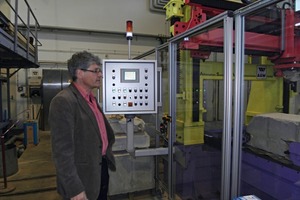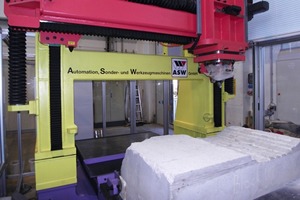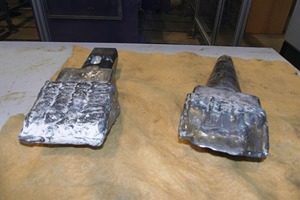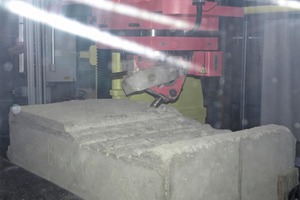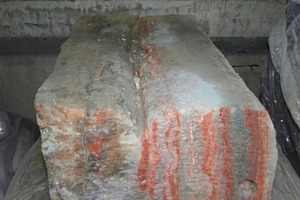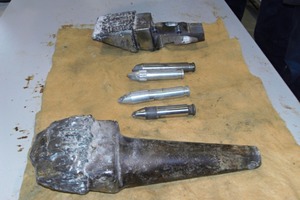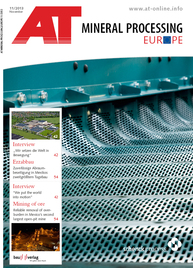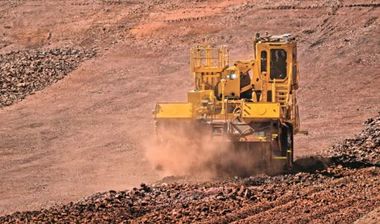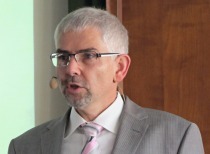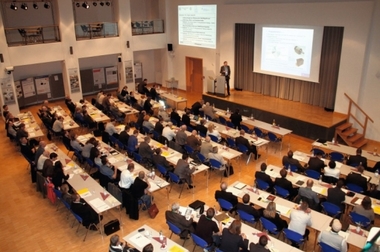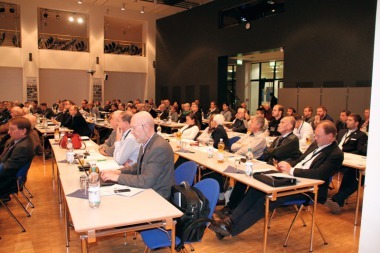Smart cutting-test facility
W ear and energy consumption are factors that have a significant impact on the costs of the mineral extraction. In the non-explosive extraction techniques now coming into increasingly widespread use, it is rock breaking, in particular, which is the prime cause of this. Both the need to make this process, in particular, more efficient, and the fact that numerous scientific studies are underway for this purpose, thus become all the more understandable.
During the non-explosive mining conference held at the TU Bergakademie Freiberg mining and technology academy last November (report in AT 10/2013, pp 18), the AT Mineral Processing editorial team took the opportunity of seeing for itself a test facility that permits research into material- and energy-efficient mining of mineral resources under conditions closely approximating reality. This test system, thanks to its capability for variation of the parameters affecting cutting, permits outstandingly good optimisation of the cutting processes in a large range of ways, as was explained to us by Dipl.-Ing. Wolfgang Gaßner (Fig. 1), of the Institute of Mining (IBS) of the Freiberg mining and technology academy.
In non-explosive extraction of minerals using cutting methods, the mineral product, and also the overlying rock, is broken out using tools which are thrust against the material and then manipulated. The test facility has been set up to investigate all the processes which can then occur. The mineral induces wear on the tool during cutting, and certain minerals are thus not suitable for this extraction method, since tool service-lives are then too short. The investigations are therefore aimed not only at the minimisation of specific energy consumption, maximisation of breaking rate and the attainment of an optimum particle-size in the ROM product, but also at the prediction and reduction of tool wear and at shifting the limit of the method‘s applicability toward harder minerals. An additional target is the reduction of noise and dust emissions.
ASW Metallbau GmbH, of Naumburg, developed and produced its special Type HXS 100-50 rock planing machine precisely for the purpose of performance of these cutting tests.
The test facility (Fig. 2) consists of a frame, a fixed twin-beam gantry with a support for a 3D measuring head, laser and tool mounting, and a movable work table to which the block of mineral to be tested is fastened. The variables for a test cut are the velocities of the tool or of the mineral sample in the x, y and z directions and the co-ordinates of the cutting pattern (cut depth and cutting-line spacing). Movements can be superimposed on one another, permitting cuts involving additional sideways movement and cuts of varying depths. Cutting speeds of up to 1.5 m/s and cut depths of up to 50 mm can be achieved, while the forces applied can reach as high as 50 kN.
The machine is equipped with ultra-modern measuring technology. A laser scanning system can be used to calculate the volume of material extracted, eliminating the need for the difficult – and less accurate – determination of the mass of mineral extracted. A high-speed camera permits recording of cutting operations at rates of up to 50 000 colour frames per second simultaneously to the measurements.
Metal-carbide cutters of various geometries (shearing, flat and round-shank picks) are used as the cutting tools, and can be fixed at differing angles of application (15° to 90°) and angels of turn (-90° to +90°). Cutter wear has a particularly great influence on cutting results, and investigation of the effects of wear state (Fig. 3) on the operating parameters of cut depth and pattern spacing is therefore of great scientific and practical importance, and forms part of the institute‘s investigation programme.
Concrete (Fig. 4) is generally used as the test material, but natural rock – sylvinite from the Soligorsk potash deposits in Belarus, for example – is used in special cases (Fig. 5).
A number of questions facing industry have already been answered - and practical solutions found - using the cutting-test facility at the IBS under the direction of its head, Prof. Dr. Carsten Drebenstedt; for the Gacko open-cast lignite mine in Bosnia-Herzegovina, for instance. The cutters on a bucket-wheel excavator at this mine, where it was necessary to remove an overlying clayey marl stratum, were wearing out after only 120 h due to the hardness properties of this material. Corresponding cutting tests performed at Freiberg made it possible to significantly extend the service-lives of these cutters. In addition, the optimum angle of application was determined, with the benefit that cutting now takes place using the whole cutter and not, as previously, applying only the shoulder. The recommendation of the use of fused tungsten carbide for the tools also resulted in the complete renewal of the cutting head.
The cutting-test facility at the Freiberg mining and technology academy‘s Institute of Mining (IBS) is an outstanding example of fruitful co-operation between scientific research and everyday mining practice.

